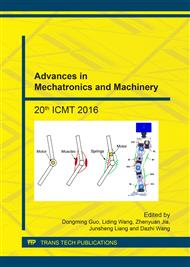[1]
Q.F. Wang, Y.T. Zhang, and Q. Xiao, Evaluation for energy saving effect and simulation research on energy saving of hydraulic system in hybrid construction machinery, Journal of Mechanical Engineering, Vol. 41, No. 12, p.135–140, (2005).
DOI: 10.3901/jme.2005.12.135
Google Scholar
[2]
T. A. Minav L.I.E. Laurila, J.J. Pyrhonen, Analysis of electro-hydraulic lifting system's energy efficiency with direct electric drive pump control, Automation in Construction, Vol. 30, pp.144-150, (2013).
DOI: 10.1016/j.autcon.2012.11.009
Google Scholar
[3]
W. J. Jiang, X. Su, H. R. Karimi. Control strategy analysis of the hydraulic hybrid excavator, Journal of the Franklin Institute. Vol. 352, No. 2, Pages 541-561, (2015).
DOI: 10.1016/j.jfranklin.2014.04.007
Google Scholar
[4]
Z. Quan, L. Quan, J. Zhang. Review of energy efficient direct pump controlled cylinder electro-hydraulic technology, Automation in Construction, Vol. 35, pp.336-346, (2014).
DOI: 10.1016/j.rser.2014.04.036
Google Scholar
[5]
T. Wang, Q. F. Wang, a n d T. L. Lin. Improvement of boom control performance for hybrid hydraulic excavator with potential energy recovery, Automation in Construction, Vol. 30, pp.161-169, (2013).
DOI: 10.1016/j.autcon.2012.11.034
Google Scholar
[6]
X. Zeng, N. Yanga, Y. Peng, Y. Zhang, J. Wang,Research on energy saving control strategy of parallel hybrid loader, Automation in Construction, Vol. 38, pp.100-108, (2014).
DOI: 10.1016/j.autcon.2013.11.007
Google Scholar
[7]
T. L. Lin, Q. F. Wang, B. Z. Hu, and W. Gong, Development of hybrid powered hydraulic construction machinery, Automation in Construction, Vol. 19, No. 1, pp.11-19, (2010).
DOI: 10.1016/j.autcon.2009.09.005
Google Scholar
[8]
X.G. Liang, T. Virvalo, Development and research of an energy saving drive in a hydraulic Crane, 7th Scandinavian International Conference on Fluid Power, p.151–161, (2001).
Google Scholar
[9]
X.G. Liang, T. Virvalo, Energy reutilization and balance analysis in a hydraulic crane, 5th International Conference on Fluid Power Transmission and Control, p.306–310, (2001).
Google Scholar
[10]
J. Nyman, K. -E. Rydberg, Energy saving lifting hydraulic systems, 7th Scandinavian International Conference on Fluid Power, p.163–177, (2001).
Google Scholar
[11]
B. N. M. Truong, D. Q. Truong, S. Y. Lee and K. K. Ahn, Study on Energy Regeneration System for Hybrid Hydraulic Excavator, 2015 International Conference on Fluid Power and Mechatronics, pp.1349-1354, 2015. (2015).
DOI: 10.1109/fpm.2015.7337331
Google Scholar
[12]
T. H. Ho, and K. K. Ahn, A Study on the Position Control of Hydraulic Cylinder Driven by Hydraulic Transformer Using Disturbance Observer, International Conference on Control, Automation and Systems, pp.2634-2639, (2008).
DOI: 10.1109/iccas.2008.4694301
Google Scholar


